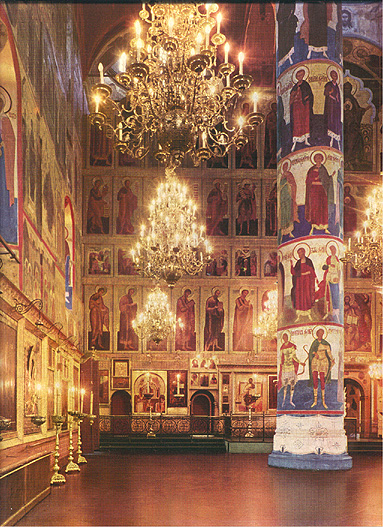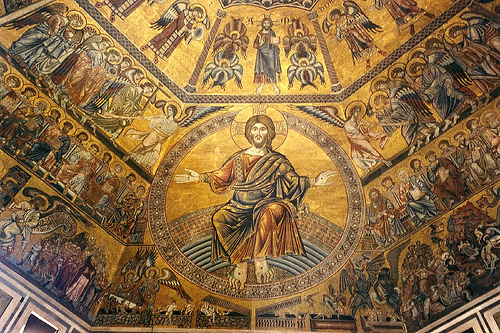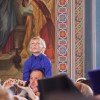Source: Holy Trinity Orthodox Cathedral
In considering the relationship of architecture and liturgical practice, we may begin by pondering the definition of liturgy, and the role of art in worship. The word “liturgy” comes from the Greek “leitourgeo” which is compounded from “laos” (people), and “ergon” (work). Literally, it means “work of the people”. Thus it may be said that in its primary sense liturgical practice is work as an effort of the people of God to commune with Him. Worship is the most important activity of Christians and therefore should be the focus of our creative endeavors, whichever form those take.
Viewed from this perspective, ecclesiastical art has the potential to become the highest expression of human creativity. If the liturgy, the Eucharistic assembly, is the supreme activity of Christian life, then every aspect of it – movement, hymnody, music, art, and space – assumes transcendental character, assisting man in the ultimate experience of communion with the divine.
“Church entrusts art with a mediating role, analogous, we might say, to the role of the priest or, perhaps better, to that of Jacob’s ladder descending and ascending. Art is meant to bring the divine to the human world, to the level of the senses, then, from the spiritual insight gained through the senses and the stirring of the emotions, to raise the human world to God, to his inexpressible kingdom of mystery, beauty, and life. […]The fine arts are rightly classed among the noblest activities of man’s genius; this is especially true of religious art and of its highest manifestation, sacred art. Of their nature, the arts are directed toward expressing in some way the infinite beauty of God in works made by human hands. Their dedication to the increase of God’s praise and of His glory is more complete, the more exclusively they are devoted to turning men’s minds devoutly towards God.” [1]

If we therefore study ecclesiastical architecture as the organization of physical space which supports the very essence of the liturgical process, that of transformation of the mundane into the sacred, then we may begin to understand how the most successful church buildings appear to transcend limitations of material reality. As Christos Yannaras writes in his book The Freedom of Morality, “the worship of the Church is art: it is the work of a communal use of material reality, building and shaping the earth’s material so as to render it capable of serving life, that existential fullness of life which is communion and relationship.”[2]
Church architecture should be primarily considered in the context of art of shaping space around ritual, as it is first and foremost the liturgical rites of the church that determine the shape and organization of the church building. In the words of Pope John Paul II, “the temple is an architecturally defined space where God proper meets Man proper.”
An interesting fact to consider is that in the English language the words “temple” and “contemplation” derive from the same Latin root “templum”. The temple can be understood as the space for contemplating the divine. As St. Symeon of Thessalonica wrote, “Splendor of the temple signifies the beauty of paradise, therefore the Divine temple pictures paradise or better to say presents the paradise heavenly gifts… In the beginning of prayers we stand outside of the temple as if outside paradise or heaven itself. And when the songs are finished and the gates open we enter the Divine temple like paradise or heaven. It means that heavenly dwellings are open to us and we got access to the Holy of Holies, we ascend to the light and approach the throne of the Lord…”[3]
During the liturgical service, clergy and faithful concelebrate the Eucharist. Therefore the space itself should complement the act of celebration of the gathered community. All parts of this space, all material objects and all physical activities are organized to the common purpose. Here we may regard the ancient Russian concept of “sobornost’” – communal consciousness in church art and architecture. The principle of “sobornost’” defines church building and art as an expression of communal consciousness of the Orthodox Church. The church building is a synthetic one, because it fulfills the function of synthesizing art, ritual and music. In a way it may be regarded as an attempt on the part of the people to define our physical environment so that it may assist us in touching the mystery of the communion with our Creator.
In ancient Russian architectural practice the ultimate goal of ecclesiastical planning was described through the concept of “stroinoe mesto” – “a place congenial to building […] whereby a building place was chosen in relation to the whole world”.[4] The word itself is related to “stroit” (to build) and “stroiny” (graceful) and shows an understanding of a building as a graceful and harmonious whole, a building as part of the created world.
Given this, we may consider the church building as a theological statement. We will then see that in its spatial structure, its iconographic scheme and the organization of its furnishings, the church is a theological cosmogram. Its interior is designed to convey the unity of the universe in God. Therefore, if the building acts as a microcosm, then its parts do not act independently of each other, but rather convey the harmony, unity and sanctity of God’s world.
Inside the body of a church building, there exists a dynamic relationship between the narthex, nave and sanctuary. The nave is potentially the sanctuary, the sanctuary is the nave in action. St. Symeon writes that “the fact that the Church has two parts, sanctuary and nave, represents Christ, who is both God and man, the other invisible, the other visible. Similarly it represents man who is both soul and body. […]The scheme of the divine temple also teaches regarding earth, heaven and the heaven above the heaven; the prenave teaches of the earth, the nave teaches of heaven, and the things of the heaven above heaven are taught by the most holy bema (altar)…”[5] And in the words of St. Maximus the Confessor, “the nave is the sanctuary in potency by being consecrated by the relationship of the sacrament toward its end, and in turn the sanctuary is the nave in act by possessing the principle of its own sacrament, which remains one and the same in its two parts.”[6]
If we now consider dynamic organization of the church building, we shall see that it follows the axes of theologically significant directions. In the horizontal plane, our movement during the liturgy proceeds from the outside through the narthex, the world, into the nave, the body of the church, and towards the altar, where the focal points of the worship – the veneration of the icons and the Eucharistic communion – are taking place. The building should then be organized in such a way that there is a natural “draw” toward the heart of the mysteries, the focus of attention and desire.
While we may say that the horizontal axis is directing the movement of the body, there is also a vertical axis which commands the movement of the spirit. The beauty and otherworldliness of Heaven is beckoning to the worshipper and filling him with longing and joy.

If we regard the different elements that are combined in the attempt to create the dynamic character of the experience of the building, we shall see that none are as important as light. Ironically, this is one element of the building that ideally is not created by man, and its successful implementation in the architecture may be regarded as the supreme accomplishment of man’s collaboration with nature. The relationship of the created “natural” light to the uncreated Light of God, as well as its natural beauty and warmth, are nowhere as keenly experienced as in the church. One is only to think of the giant dome of Hagia Sophia in Constantinople which appears to float on the ring of small windows; the Cross of the Church of the Light in Tokyo; the glorious glow of the mosaics in the dome of the Florentine Baptistery and the light well on its top; the mosaics of St. Sophia in Kiev and the frescoes of the Cathedral of Dormition in Moscow that seem to float over the darkness of the lower church; and of every church building where the spirit is awed and soars at the same time as one moves through the space. It is the reminder of “the light” that “shines in the darkness, and the darkness did not overcome it. “[7]
Yet another important part of experience of church architecture is not in what the building is filled with, but what is not there – the empty space pregnant with presence of the divine. In every great church building there is emptiness – not of the sort of hollow, lonely nothingness, but rather “silence, clarity, and transparency. Emptiness may resound without sound, may be filled by its potential to be filled, and make open what is complete…”[8]
This kind of emptiness conveys readiness, expectation and, again, desire to be filled with the sublime presence. The building does not have to be enormous for that, but it does need to be generous, and refrain from the temptation of becoming overdecorated and overcrowded.
When one enters a great church, one’s experience of the space is inevitably a transcendent one, humbling even the faithless people. One stands in awe of God’s glory ever-present among men, and worshipped in His house. The Russian emissaries to Constantinople who had stood in the nave of Hagia Sophia reported to Prince Vladimir upon their return: “we knew not whether we were in heaven or on earth. For on earth there is no such splendor or such beauty, and we are at a loss how to describe it. We only know that God dwells there among men.”[9]
“Truly the church is Heaven upon earth; for where the throne of God is, where the awful sacraments are celebrated, where the angels serve together with men, ceaselessly glorifying the Almighty, there is truly Heaven. And so let us enter into the house of God with the fear of God, with a pure heart, laying aside all vices and every worldly care, and let us stand in it with faith and reverence, with understanding attention, with love and peace in our hearts, so that we may come away renewed, as though made Heavenly; so that we may live in the holiness natural to Heaven, not bound by worldly desires and pleasures.”[10]
“After these things I looked, and behold, a door standing open in heaven. And the first voice which I heard was like a trumpet speaking with me, saying, ‘Come up here, and I will show you things which must take place after this.’ Immediately I was in the Spirit; and behold, a throne set in heaven, and One sat on the throne. And He who sat there was like a jasper and a sardius stone in appearance; and there was a rainbow around the throne, in appearance like an emerald. Around the throne were twenty-four thrones, and on the thrones I saw twenty-four elders sitting, clothed in white robes; and they had crowns of gold on their heads. And from the throne proceeded lightenings, thunderings, and voices.
Seven lamps of fire were burning before the throne, which are the seven Spirits of God. Before the throne there was a sea of glass, like crystal. And in the midst of the throne, and around the throne, were four living creatures full of eyes in front and in back. The first living creature was like a lion, the second living creature like a calf, the third living creature had a face like a man, and the fourth living creature was like a flying eagle. The four living creatures, each having six wings, were full of eyes around and within. And they do not rest day or night, saying: ‘Holy, holy, holy, Lord God Almighty, Who was and is and is to come!’ Whenever the living creatures give glory and honor and thanks to Him who sits on the throne, who lives forever and ever, the twenty-four elders fall down before Him who sits on the throne and worship Him who lives forever and ever, and cast their crowns before the throne, saying: ‘You are worthy, O Lord, to receive glory and honor and power; for You created all things, and by Your will they exist and were created.’”[11]
[1] Built of living stones (Catholic guidelines on Art, Architecture and Worship). USCCB, Washington, 2000
[2] Christos Yannaras, The Freedom of morality. St. Vladimir’s Seminary Press, 1996
[3] St. Symeon of Thessalonica, A conversation on the sacred rites and Church sacraments
[4] Oleg Shvidkovsky, The Harmony of interaction. Moscow: Stroiizdat, 1984
[5] St. Symeon of Thessalonica, On the Divine temple
[6] St. Maximus the Confessor, Mystagogy
[7] John 1:5
[8] Michael Benedikt, For an architecture of reality. New York: Lumen Books, 1987
[9] The Russian primary chronicle, Laurentian text. Cambridge: The Medieaval Academy of America, 1953
[10] St. John of Krondshtadt, My life in Christ
[11] Revelations 4:1-11















